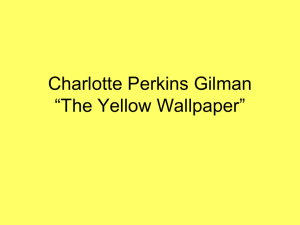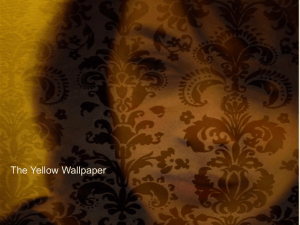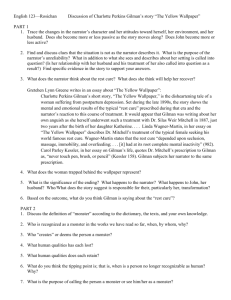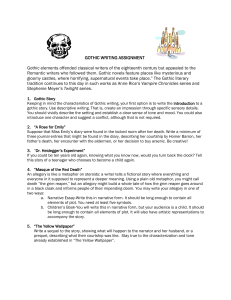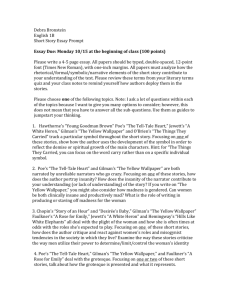The topic of Feminism in literature can start to get as
advertisement
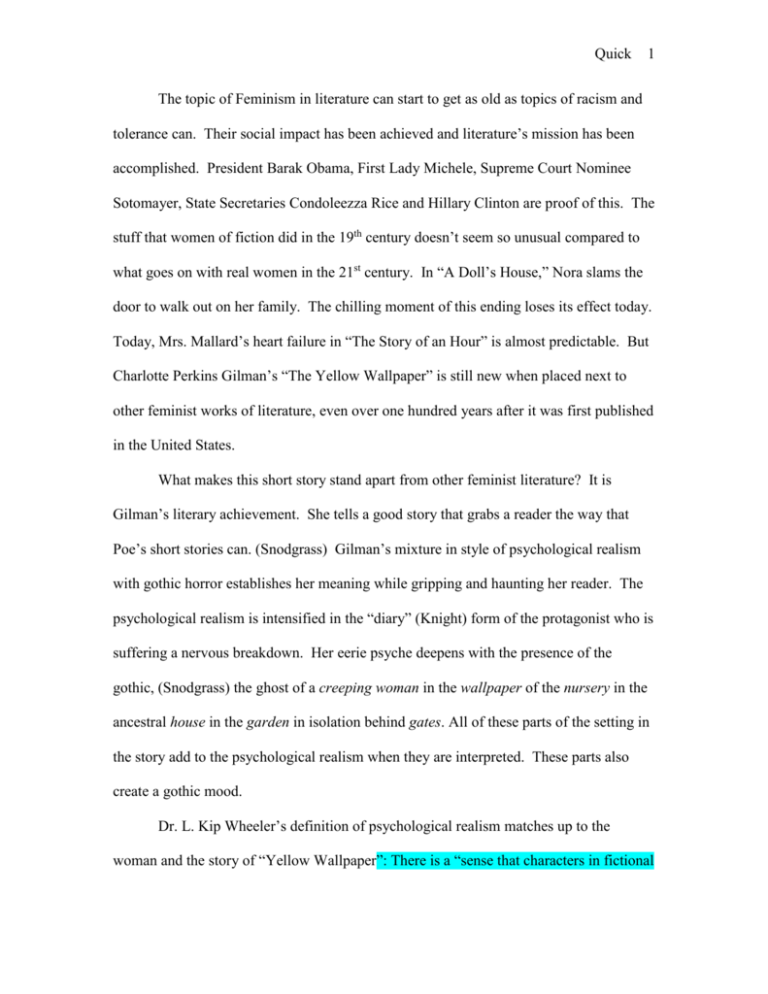
Quick 1 The topic of Feminism in literature can start to get as old as topics of racism and tolerance can. Their social impact has been achieved and literature’s mission has been accomplished. President Barak Obama, First Lady Michele, Supreme Court Nominee Sotomayer, State Secretaries Condoleezza Rice and Hillary Clinton are proof of this. The stuff that women of fiction did in the 19th century doesn’t seem so unusual compared to what goes on with real women in the 21st century. In “A Doll’s House,” Nora slams the door to walk out on her family. The chilling moment of this ending loses its effect today. Today, Mrs. Mallard’s heart failure in “The Story of an Hour” is almost predictable. But Charlotte Perkins Gilman’s “The Yellow Wallpaper” is still new when placed next to other feminist works of literature, even over one hundred years after it was first published in the United States. What makes this short story stand apart from other feminist literature? It is Gilman’s literary achievement. She tells a good story that grabs a reader the way that Poe’s short stories can. (Snodgrass) Gilman’s mixture in style of psychological realism with gothic horror establishes her meaning while gripping and haunting her reader. The psychological realism is intensified in the “diary” (Knight) form of the protagonist who is suffering a nervous breakdown. Her eerie psyche deepens with the presence of the gothic, (Snodgrass) the ghost of a creeping woman in the wallpaper of the nursery in the ancestral house in the garden in isolation behind gates. All of these parts of the setting in the story add to the psychological realism when they are interpreted. These parts also create a gothic mood. Dr. L. Kip Wheeler’s definition of psychological realism matches up to the woman and the story of “Yellow Wallpaper”: There is a “sense that characters in fictional Quick 2 narratives have realistic ‘interiority’ or complex emotional and intellectual depth, including perhaps subconscious urges and fears they are not aware of.” The woman reveals herself through both her inner thoughts and outside circumstances as she sneaks to write her “diary entries” (Knight): “John is a physician, and perhaps—(I would not say it to a living soul, of course, but this is dead paper and a great relief to my mind)— perhaps that is one reason I do not get well faster. You see he does not believe I am sick!” (Gilman). This woman of “intellectual depth” (Wheeler) senses the irony in her situation because her husband doctor (who believes that she is healthy) is truly the one making her more and more sick. Early in this feminist story of psychological realism Gilman has established the “complex emotional ‘interiority’” (Wheeler) and circumstances of a woman who is up against the two men most closely related to her, a husband and a brother, and they are both physicians “of high standing” (Gilman). Yet she has the “subconscious urge” (Wheeler) to write despite her unknown “fear” (Wheeler) of her brother and husband: She will “write…in spite of them…having to be so sly about it or else meet with their heavy opposition” (Gilman). Writing in her “diary” is a way for her to fill her “urge” to escape her “fear”. D’Ammassa writes of the mental health of the sick woman of the story as “the psychology of the narrator-protagonist.” Gilman can write so honestly and realistically as narrator-protagonist because she herself had been treated for “despondency and postpartum depression” (Werlock). She experienced first hand “the psychological subjugations caused by some marriages and some entries into motherhood” (Werlock). Though she speaks of her husband’s tender loving care for her, his overpowering presence in her life is right there if a reader looks for it. Her “brother…says the same Quick 3 thing” as what “John says” and “John says” a lot to his wife in this story. John is a great talker. John “thought” and “John said”. John “absolutely forbids” her, he “assures friends and relatives” about her, “John laughs at” her and “scorns openly” her “talk” (Gilman). “John says” many times over many things directly opposite of what his wife says. She wants to meet with stimulating company, get out of doors, work, and get physical activity but John disagrees with all of this. It seems he says much as the husband master but never listens to his wife subject whose opinion does not count at all. Finally, “John hates for” her “to write a word” (Gilman). “Deprived of the freedom to write openly, which she believes would be therapeutic, the narrator gradually shifts her attention to the yellow wallpaper in the attic nursery where she spends her time” (Knight). This is where the gothic aspect of the story starts to kick in. Gilman “concentrates so completely on the psychology of the narrator-protagonist that the events described could be either supernatural or delusional” (D’Ammassa). This psychological concentration makes room for the gothic atmosphere of the story. Gilman’s writing becomes gothic in its “design…to thrill readers by providing mystery and …accounts of… villainy …and the supernatural” (Wheeler). John’s actions make him a villain. He insists on the “rest cure” and limits his wife to loneliness in the nursery. Soon, the pattern in the wall paper becomes the bars that confine her in her prison. (D’Ammassa) The power he uses over his wife is like the torturer in a dungeon. And the nursery itself is “redefined” to make “the home as an alien space, an extension of the gothic dungeon” (Snodgrass) or a remote castle tower. Gilman’s narrator-protagonist and her husband John in the “haunted house” form the perfect gothic marriage. The “female characters Quick 4 are threatened by powerful or impetuous male figures, and description functions through a metonymy of fear by presenting details designed to evoke horror, disgust, or terror” (Wheeler). The setting of the “ancestral halls” of a “colonial mansion, a hereditary estate” also opens the story with a hint of the gothic. “It is quite alone standing well back from the road, quite three miles from the village…[and] there are hedges and walls and gates that lock” (Gilman). According to J A Cuddon, this is another “convention of gothic literature.” To “include wild and desolate landscapes, ancient buildings such as castles with dungeons, torture chambers, secret doors, and winding stairways; apparitions, phantoms;…an atmosphere of brooding gloom…” (Wheeler) John and his sister Jennie seem like the jailers who trap the wife/sister four times over within the hedges within the walls, within the nursery, within the bed against her will. Snodgrass explains the meaning behind these gothic suggestions as they relate to the woman psychologically: “As a symbol of claustrophobic oppression, the author's unnamed character, a new mother struggling for selfhood, passes through a hedge, locked gates, and an entranceway before languishing in total seclusion, like a scolded child returned to a suffocating womb.” That is why the nursery is a symbol. She is being treated like a child. Werlock calls this “infantilization.” Once the woman reaches this point of entrapment, according to the rules of gothic writing, the yellow wallpaper becomes the “metonymy of fear” for both the narrator and the reader. It is a psychological horror for anyone to be victimized. When the woman actually keeps a diary that describes step by step her increasing fear and madness it is both psychological and horrible. Since John says she isn’t supposed to dwell on her illness and he forces her to rest in her room, she switches her attention to the house and Quick 5 then more and more to the wallpaper. Therefore, as a “metonymy of fear,” the yellow wallpaper becomes the central symbol to this story in a psychological and gothic way. The woman at first only notices how ugly the yellow wallpaper is after she has described the rest of the nursery. But the wallpaper slowly becomes her obsession. She describes it, then personifies it, then gives it a life, then interacts with it. “…the patient nurses a dormant rage. To vent her fury, she redirects hatred toward the arabesque wallpaper (Snodgrass). The words of the wallpaper really describe words that are like her husband’s relationship with her. “It is dull enough to confuse the eye in following, pronounced enough to constantly irritate and provoke study, and when you follow the lame uncertain curves for a little distance they suddenly commit suicide—plunge off at outrageous angles, destroy themselves in unheard of contradictions” (Gilman). “She speaks indirectly of the insidious misery of marriage and hints at coercion and violence in terms of the hideous wallpaper” (Snodgrass). "You think you have mastered it, but just as you get well under way in following, it turns a back-somersault and there you are. It slaps you in the face, knocks you down, and tramples upon you. It is like a bad dream" (Gilman). In this passage, the reader soon realizes that in her mind the woman connects the wallpaper to her husband because he has “trampled” her true nature. He refused to give her space for her creativity, sociability, and independence. She was forbidden to write, see other company, or work. Behind the psychological portrait is the message “that institutionalization within four walls to punish sensitive, creative women for being themselves is a sure route to madness” (Snodgrass). The wife tried to get around her husband “through a series of rebellious acts” (D’Ammassa) and her final rebellion is to release the creeping woman from the pattern of the wallpaper. Quick 6 Snodgrass calls the creeping woman a doppleganger of the narrator-protagonist. A doppelganger is a theory and a literary technique that works for both the psychological realism and gothic of this story. It “describes a character whose divided mind or personality is represented as two characters” (Quinn). The psychological realism works if the woman goes crazy and hallucinates about the creeping woman. This is where one character is imagining a “double image” of herself. On the gothic level, the creeping woman is a ghost, a second character, trying to escape the wallpaper and the sympathetic woman is desperate to help her out. Either way, Gilman achieves both effects on the reader to double the spookiness they feel. If the woman has gone out of her mind in this way it is eerie, and if the creeping woman is a ghost, it does seem to be evil like it is taking possession of the protagonist’s soul. “Whether this breakdown was inherent in her situation or whether the wallpaper possessed some latent power to influence the mind of the living is left to the reader's interpretation” (D’Ammassa). Other scholars like to interpret the psychology and the gothic in drawing meaning from the end of the story. Showalter focuses on locked door: “Charlotte Gilman's heroine, and for many of their sisters in literature, a room of one's own is a prison as well as a sanctuary. Psychologically enfeebled by their conditioning, they dare not defy society to do and say what they want; they struggle in a vague way to be let out of their rooms, but never understand that by this time the doors are locked from the inside.” Showalter thinks that the woman’s mind is forever shut down in its madness by her husband and by society. Knight also sees the victory of the husband over his wife: “John breaks into the room and, after witnessing the full measure of his wife's insanity, faints. Quick 7 Significantly, however, he is still blocking his wife, literally and symbolically obstructing her path so that she has to "creep over him every time!" He further explains the defeat. “While some critics have hailed the narrator as a feminist heroine, others have seen in her a maternal failure coupled with a morbid fear of female sexuality. Some have viewed the story, with its yellow paper, as an exemplar of the silencing of women writers in 19thcentury America…” Golden also focuses on the closing words of “The Yellow Wallpaper” by explaining an illustration (done by the artist Hatfield) that was included with early publications of the story. Golden contrasts the appearance of the woman in the first two illustrations to the third and final illustration of the “endpiece” that is captioned, "I had to creep over him every time." The dramatic shift in the portrayal of the narrator between the first two drawings and the third suggests that the narrator succumbs to full-blown madness at an alarming rate and passes through "the gradations from slight mental derangement to raving lunacy,"… The illustration captures the narrator in an act very different than covert writing: creeping on the floor in front of and over John. Conveying a decrepit eeriness, her long and wild dark hair has been freed from the constraints of its late Victorian-style coiffure to accentuate her madness…Although there are no indications of a change in the narrator's appearance in the text…, Hatfield's depiction responds to the traditional conception of the long- and wild-haired madwoman in literature…(Golden) Showalter: “"The woman, of course, is herself, trying to break out of her life; but she can do so only by being mad. In the story's terrifying conclusion, she locks herself in her room, systematically ripping the paper off the walls. In the role of madness, she can express her aggressions against her husband; and when at Quick last he breaks into the room, and faints in shock at the sight of her, there is a triumph in her narrative. Yet she is truly mad; she has defeated him only by destroying herself.” Conclusion: Feminism achieved gothic and psychological realism=artistic greatness “It was not intended to drive people crazy, but to save people from being driven crazy, and it worked.” (Gilman “Why I Wrote…”) 8
